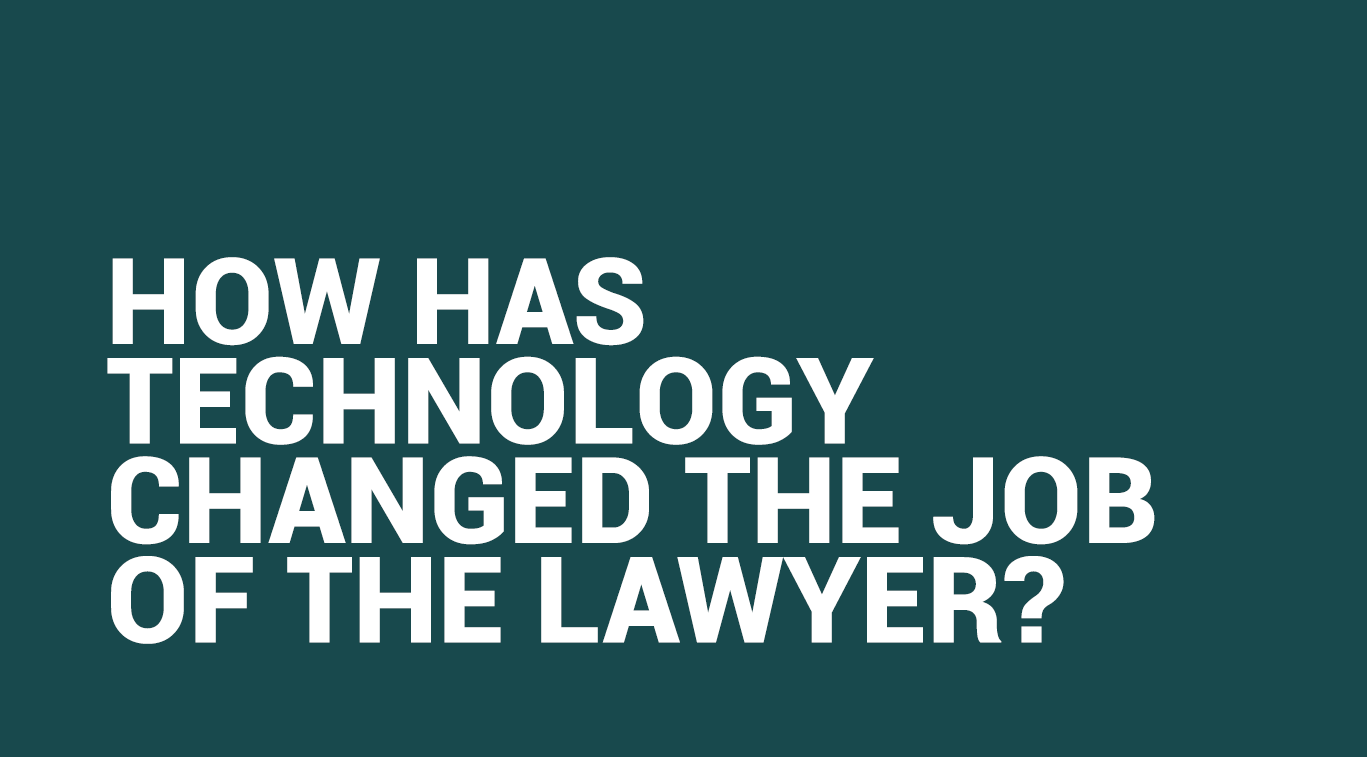8 Signs You Need to Invest Legal in Technology

Written by Maryam Khan
Blogger

Given its traditional nature, the legal sector has been hesitant to adopt new ways of working compared to other industries where technology plays a crucial role in business development. The use of legal technology offers substantial cost savings and improves productivity resulting in its investment being taken more seriously by law firms in recent years. Innovation is now a key priority for law firms to stay competitive within the legal market, provide the highest quality client service and retain the best talent. However, the shift to using technology in the legal sector is not easy, as many firms still have reservations about taking this step. This article discusses why law firms question the use of technology and outlines several signs that indicate when a law firm may need a technological upgrade.
Why are some law firms reluctant to use legal technology?
For many reasons, law firms and legal departments are reluctant to integrate legal technology into their business functions. However, these firms may be missing out on an opportunity to improve their internal workflow, and overall client experience as the benefits of using legal technology in most cases outweigh the risks, especially if strict compliance, due diligence and security measures are in place.
Despite this, some law firms still struggle to balance understanding the long-term and short-term impact of investing in legal technology. As a result, they prioritise the short term costs over the long term benefits and choose not to invest. Lastly, there is a common misconception that investment in legal technology is only suitable for large international law firms instead of smaller, niche and boutique law firms with fewer employees and a comparatively lower caseload. However, this is not the case as legal technology solutions can be customised to a law firm’s size, practise area and business goals.
Startup & Operating Costs
The startup and operating costs associated with integrating legal technology software can be quite high, especially for small and boutique law firms. This initial cost results in reduced short-term profit, which deters firms from improving their internal systems. However, Gartner has predicted that legal technology budgets will increase threefold through 2025 as legal counsel face pressure to increase efficiency as they face greater workloads [1]. Law firms need to consider the long-term return on investment of a comprehensive legal practice management solution instead of fixating on the short-term operating costs. Investing in tools that improve a firm’s overall productivity has a huge positive impact in the long run which offsets the initial implementation costs [2].
According to Thomson Reuter’s 2021 Small Law Firm Business Leaders report, 46% of the respondents stated that they ‘definitely will be using technology to help reduce costs in the upcoming years [3]. The report highlighted that greater use of technology was considered the most popular step to improve firm-wide performance [4]. This report provides great insight into small law firms’ priorities and clarifies the misconception that smaller firms cannot invest in legal technology.
Complex & Inconvenient Implementation Process
Law firms may also find the initial implementation process quite time-consuming and complicated.
The implementation process involves transferring data from existing systems to new software and training lawyers on using the new legal software. Law firms may not want to disrupt their current workflow to improve a system that already works for them. However, doing so results in an opportunity to increase efficiency and streamline workflow in the long run, resulting in a lot more time being saved in the future.
Data Protection & Security Risks
Data protection in cloud computing and security risks are ongoing concerns associated with integrating legal technology to create more capabilities within a firm [5]. Previously, law firms were extremely hesitant to move to the cloud as electronically storing confidential data seemed very risky.
However, the legal sector was quite late to the game. Secure cloud-based legal software now plays an extremely important role in the professional services industry. Practice management systems, client relationship management software and contract automation solutions are now more advanced, secure and stable, enabling lawyers to work more efficiently. As technology advances, so do the security measures associated with its usage. This advanced legal document security eliminates data protection and security risks when storing and sharing confidential information electronically.
8 Signs You Need To Take The Leap
Focusing too much on short-term challenges associated with legal technology will prevent you from taking advantage of the opportunity to improve internal workflow in the future. You should read this article with an open mind and carefully consider whether investing in legal technology is the right step for you if you are concerned about the issues discussed earlier, have the same doubts about legal technology, or are facing any of the challenges listed below.
1.You are struggling to create a paperless office and work remotely.
Storing all client documents and paperwork in a filing cabinet can be extremely inefficient and can create problems when trying to access documents that are needed urgently. Paper files can also be easily lost and damaged. This poses significant security risks compared to storing files digitally, which are less likely to be misplaced. Not only is paper filing riskier, but it is also costly. Law firms can repurpose the space used to store thousands of files in much better ways to improve the firm’s functionality. Those storage spaces can be used as additional office space or a meeting room. Alternatively, law firms can simply not use that space and reduce the square footage in their lease, which offsets the cost of storing files digitally and transitioning to the cloud [6].
Following the pandemic, remote working was a huge challenge for firms with no online working capability. Legal technology needs to be adopted to adopt hybrid working, especially during the pandemic. Law firms cannot afford to miss deadlines simply because a Partner tested positive for Covid-19, and they could not get their signature on time to sign a document. Investing in electronic signature software, client intake systems, contract management systems, and practice management systems makes remote work extremely smooth. Remote working has many additional benefits for a law firm and its employees, which law firms can only enjoy if the right technologies are in place. Look at our article here to learn more about using legal technology to embrace hybrid working.
2.Your lawyers do a lot of manual data entry.
Manual data entry is a major day-to-day operation across multiple industries, including the legal sector. Manual data entry is extremely common for law firms and is a major challenge. A centuries-old practice involves repetitive and duplicative data, which is extremely tedious. Law firms deal with huge amounts of data and the average typing speed of a data entry specialist is around 50 to 80 words per minute [7]. This takes much time, but it also involves the additional cost of hiring a data entry specialist. This process can be completely automated, saving law firms time and money.Manual data entry involves several risks for law firms, the biggest one being typos. This includes entering the wrong figure, entering the wrong data or simply getting information mixed up. While typos
may seem like a minor mistake, it is an extremely expensive and embarrassing error in the legal sector. One expensive typo was when the Japanese financial company Mizhuo lost a quarter of a million dollars in less than a day due to an administrative typo when selling shares of a company on the Japanese stock exchange. The bank accidentally listed the shares of the company at one yen each instead of 610,000 yen. This resulted in Mizuho losing nearly its entire profit from the year before in one day. [8]. Such mistakes grab media attention and can damage the professional reputation of a law firm. Law firms can eliminate such human errors simply by automating the data entry process using machine learning and artificial intelligence. If you are looking to be a future-facing law firm, data entry automation should be first on your list of priorities due to its faster turnaround time, easier scalability and low-cost implementation [9].
3.You do not have a centralised workflow system.
A centralised workflow system is a key to increasing a law firm’s efficiency. A centralised workflow system is connected to other systems within the firm, enabling greater information sharing and increasing collaboration and communication levels. Many lawyers currently have to access a document through a document storage system, attach it to an email and send it back and forth with their client or opposing counsel until they receive the final document with all the amendments. This can be quite inefficient, confusing, and more time-consuming than a contract management system where multiple parties can edit documents in real-time.
Therefore, investing in advanced legal technology solutions with multiple features allows lawyers to complete different tasks through one system interactively [10]. This restricts the sharing of confidential information to only those who need to see it, but it also avoids complicated email chains where information can get lost. Lastly, these systems are designed to have user-friendly access, making them extremely easy to use, especially for those not too tech-savvy. Not all legal technology platforms require training sessions; they are designed and made in a way that increases accessibility and eliminates complications [11].
4.Your profits are not increasing.
Clients expect more value for money now than ever, which puts downward pressure on revenue. There have been times when clients refuse to pay for administrative costs or demand alternative billing arrangements [12]. This is extremely inconvenient for law firms who often have to absorb these administrative costs, decreasing their overall profit. As a result, you may have to reduce your administrative costs. Investing in legal technology can help with that. Contract automation, smart contracts and practice management tools have several features which improve a law firm’s workflow. This includes client portals which allow for greater communication.
Moreover, practice management systems improve time tracking, billing, and invoicing tools to monitor the firm’s performance periodically. This regular tracking generates insights every financial quarter which law firm management can use to build a business growth strategy and increase profits. Lastly, with legal technology, you are no longer spending valuable time on administrative tasks and can allocate that time to build a stronger relationship with your client or to work on more intricate cases which require your legal expertise.
5.Your clients are more technologically advanced than you.
The main role of a lawyer is to act as a commercial and legal advisor to their clients. Today law firms provide legal services to some of the most technologically advanced companies globally. It only makes sense for law firms representing those clients to match their level of technological advancement. You will need to meet your client’s expectations regarding the functionality of your systems. If your internal systems are outdated, cause delays, and are simply inefficient, your clients will look elsewhere. Features like client portals within legal practice management systems are easily customisable and make communicating and collaborating on projects much more seamless. Not only does it make a legal department more organised, but it also ensures that the relationship between a law firm and its client is being successfully managed.
6.You are struggling to take on new work.
Law firms can increase their current workload capacity using legal technology. Technology has the power to streamline workflow and speed up legal services [13]. Through document automation, lawyers can complete lengthy document reviews a fraction of the time. Through machine learning and artificial intelligence, internal documents are automatically generated, meaning that lawyers no longer have to spend their time on repetitive tasks like drafting basic contracts. Lawyers can spend the time saved through automation on other tasks which they did not have the time for before. Digitising current processes to reallocate more hours has become a popular strategy adopted by law firms [14]. Through automation, tasks like document reviews, due diligence, and contract drafting are completed consistently without assigning a lawyer to finish the job. Therefore, investing in legal technology ensures that your law firm is working at full capacity and has cut ties with inefficient systems.
7.Your employees are demanding hybrid and flexible working.
The number of people wanting to work remotely at least one day a week has grown by 50% since the start of the pandemic, going from 37% to 76%, according to the 2021 Report on the State of the Legal Market [15]. Additionally, two-thirds of UK lawyers have declared that remote working has positively impacted their wellbeing [16]. Lawyers are interested in hybrid working or at least some form of remote working options. Investing in legal technology is the only way law firms can meet the demands of law firm employees and successfully facilitate remote working. If law firms stick to their traditional approach and fail to provide the desired working conditions, their employees will simply leave and join a firm that offers flexible working. Therefore, firms that want to retain their talent and attract the best candidates should be open to hybrid working, which can only be possible by investing in legal technology such as legal cloud solutions, document automation, or contract automation.
8.You are concerned about the security of your documents.
Storing physical documents can be a huge security risk as it can become difficult to manage who has access to the files. If you store your documents electronically, all files can be password-protected, and access to information can be strictly limited. Additionally, storing documents on the cloud is safer as physical documents are more likely to get lost or damaged by employees. Case-file management software and legal document management solutions play a vital role in organising paperwork to avoid such risks. Moreover, law firms are facing cyber threats like phishing, malware and ransomware attacks now more than ever compared to previous years. Law firms are becoming a major target for hackers considering the confidential nature of their business. If you have recently been a victim of a cyber threat or want to avoid one in the future, you may want to update your current systems to ensure that you have invested in the right legal technology with the appropriate security measures.
Final Words
Technology is the key driver in law firm modernisation and innovative legal services. If you are currently facing any of the challenges discussed in this article, investing in the right legal technology should be the next step for your firm to stay competitive in the legal market and grow as a business.
References
[1]’Gartner Predicts Legal Technology Budgets Will Increase Threefold by 2025’, Gartner.com (2021) at https://www.gartner.com/en/newsroom/press-releases/2020-02-10-gartner-predicts-legal-technology-budgets-will-increase-threefold-by-2025
[2] Ibid
[3]Thomson Reuters, ‘2021 Law Firm Business Leaders Report’ (2021) at https://legal.thomsonreuters.com/en/insights/reports/2021-law-firm-business-leaders/form?gatedContent=%252Fcontent%252Fewp-marketing-websites%252Flegal%252Fgl%252Fen%252Finsights%252Freports%252F2021-law-firm-business-leaders
[4] Mark Haddad, ‘The Advantage of Better Technology in a Small Law Firm’, Thomson Reuters (2021) at https://www.thomsonreuters.com/en-us/posts/legal/better-technology-small-law-firm/
[5] ‘Technology Challenges and Opportunities Law Firms Are Currently Facing’, SC&H Group (2021) at https://www.schgroup.com/resource/blog-post/law-firm-technology-challenges-and-opportunities/
[6] Paul Diamond, ‘Cloud Storage vs. On-Premises Servers: 9 Things To Keep In Mind’, Microsoft (2020) at https://www.microsoft.com/en-gb/microsoft-365/business-insights-ideas/resources/cloud-storage-vs-on-premises-servers
[7] ‘What Is Manual Data Entry? Why Do Companies Use it?’, iTech (2021) at https://itechdata.ai/manual-data-entry/
[8] ‘Typos, Missing Commas, And Other Grammatical Mistakes That Lef To Huge Losses’, Economic Times (2018) at https://economictimes.indiatimes.com/magazines/panache/typos-missing-commas-and-other-grammatical-mistakes-that-lead-to-huge-losses/flying-off-the-handle/slideshow/65337120.cms
[9] Ibid (7)
[10]’Why Legal Workflow Automation Is Important to Law Firm Success?’, Mattersuite at https://www.mattersuite.com/blog/why-legal-workflow-automation-is-important-to-law-firm-success/
[11] Ibid
[12]
[13]’Legal Technology in 2022: 3 Little-Known Reasons Law Firms Will Thrive In The Digital Transformaiton’ at https://www.iridium-technology.com/blog/3-reasons-legal-tech-will-thrive-in-2022/
[14]Ibid
[15] ‘2021 Report on the State of the Legal Market: An ‘inflection point’ for law firms’, Thomson Reuters (2021) at https://www.thomsonreuters.com/en-us/posts/legal/state-of-the-legal-market-2021/
[16] John Hyde, ‘Lawyers Want Remote Work And Even Reduced Hours, Finds Survey’, The Law Society Gazette (2021) at https://www.lawgazette.co.uk/news/lawyers-want-remote-work-and-even-reduced-hours-finds-survey/5108166.article








